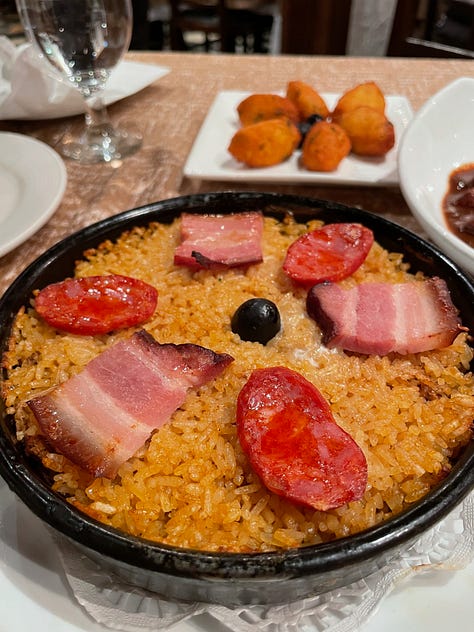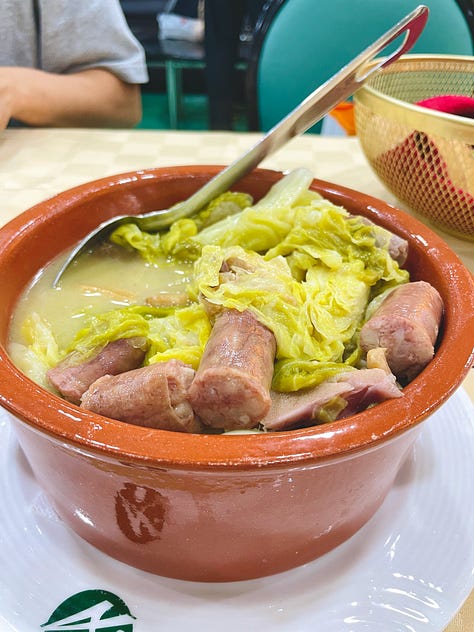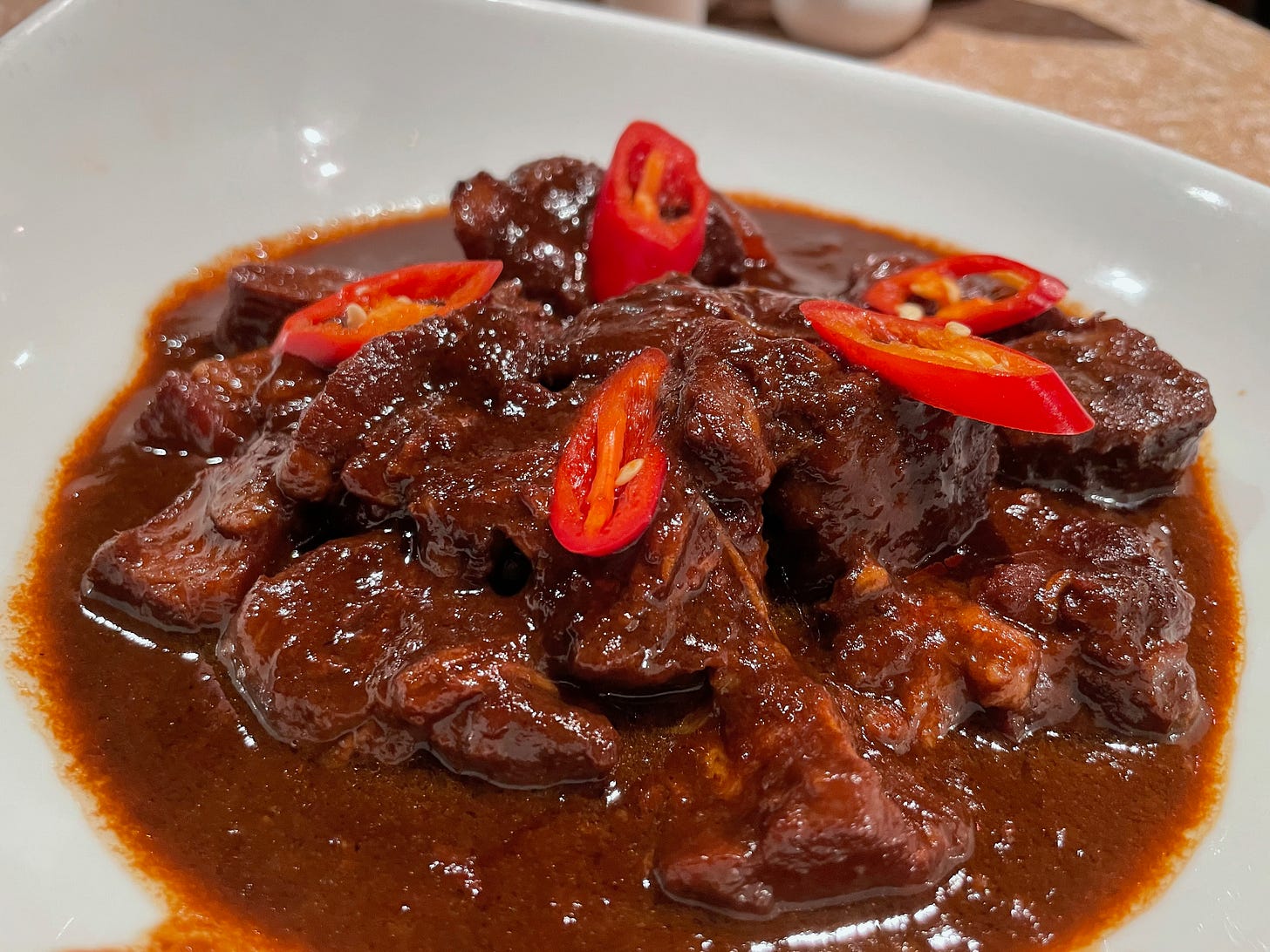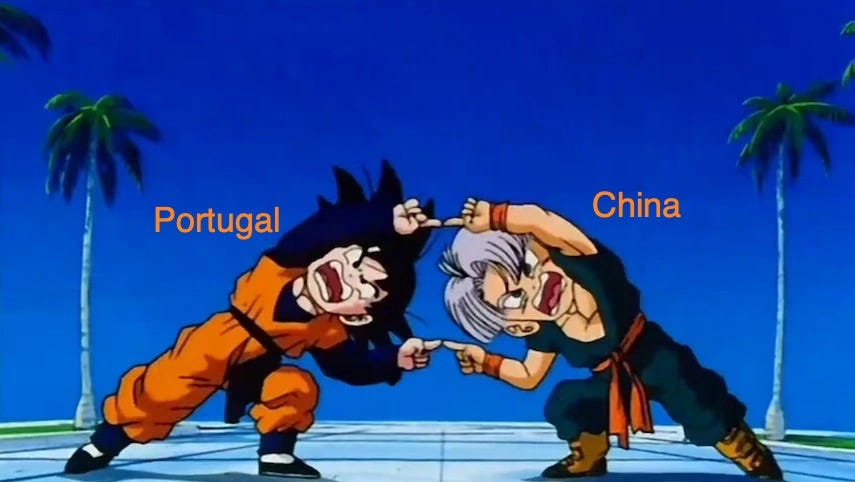Recreating Macau's Tamarind Pork (Porco Balichão Tamarindo)
Attempting to make a borderline endangered Macanese dish, in a modern kitchen.
Porco Balichão Tamarindo is a Macanese dish, and it’s not just a tasty stew — it’s a dish that really changed the way I looked at food, and how food spreads.
The city of Macau, of course, wears its cross cultural influences on its sleeves. While you can find Portuguese-inspired restaurants meandering the city’s charming narrow alleys (and certainly its gauche casinos), I find the Cantonese fare to be incredibly underrated as well — the sheer density of it all makes for some pretty fantastic food crawls.
But most fascinating, perhaps, is the city’s local cuisine. Because unlike the Brits across the estuary in Hong Kong, the residents of Macau were often mixed Eurasians — and over the years developed their own unique cuisine. Their own variant of egg tarts most famously, but also stuff like ‘fat rice’ and a shrimp paste-seasoned mixed stew called tacho (sometimes referred to by Cantonese as “gweilo Buddha jumps over the wall”):



While over the years this fare is getting increasingly endangered (you could probably count the good explicitly-Macanese restaurants out there on one hand), it’s a cuisine that’s perhaps surprisingly had a bit of international reach nonetheless. Perhaps it’s a bit of a reflection of our food world today: if you’re someone that finds yourself straddling between the worlds of Chinese food culture and Western food culture — certainly not an overly rare sight in our globalized world — think it’s really quite natural, I think, to be intrigued by the people that came before us in Macau.
Before Hong Kong Chacaanteng were serving up a Wild West of Canto-Western fusion, well before David Chang was slinging Pork Belly Guabao in the east village… there were there the Macanese people. With their Chinese influences and their western influences — the “original fusion cuisine”.
Is Macanese Food Really Cantonese-Portuguese Fusion? The Case of Tamarind Pork.
And that’s the line that the food media tends to repeat about Macanese cuisine — I mean, I’ve definitely referred to it as a ‘fusion’ in our videos as well.
But then, if Macanese cuisine is “Cantonese-Portuguese fusion”, how are we to make sense of the aforementioned Porco Balichão Tamarindo?
When cooking this, there are certainly moves that could be conceivably categorized as ‘Canto-western’. The fatty pork is marinated with soy sauce, then pre-fried to brown and create a fond. The base of the braise is then cooked with aromatics (onion and garlic, generally) and fermented shrimp paste, and then the concoction is stewed with jaggery — i.e., dark brown sugar.
Nothing overly odd. But then the stew finishes with the titular tamarind juice for a sour kick, and that’s where things get weird. Because Cantonese food doesn’t use tamarind, and (at least from what I know), neither really does Portuguese. So… what’s going on?
Perhaps we could to get a small clue from the ingredient list (left):



From what I’ve read, the general sort of ‘southeast Asian’ shrimp paste — e.g. the common sort that you might see in Malaysia or Thailand (center) — is not a direct sub for Macau’s traditional Balichão. Instead, given that there’s no Macanese equivalent of Lee Kum Kee, in the Macanese diaspora, people tend to recommend a Filipino shrimp sauce called ‘Bagoong Alamang’. It’s regarded as much closer to historical Balichão, and the obsessive can then opt for mixing that with some of what it’s missing, as compared to traditional Balichão recipes.
So, cool. I can quite easily get Bagoong Alamang on Taobao… so with my trusty jar of Filipino Shrimp paste in hand I was ready to make myself some Macanese Tamarind Pork. But in order to ensure that I was using the ingredient right before charging forward, I decided to check YouTube to see how the product is used in the Philippines (you never know if there are little culturally-obvious preparatory steps that you might be missing).
What I found… kinda messed with my head:
The combination of Bagoong Alamang and Pork seems to be equally classic to the Philippines — perhaps most famously in a braise called binagoongan, but it was the above sauce-form that was the real mindfuck for me.
Because like… this is so close to the process for Porco Balichão Tamarindo, right? Fatty pork? Check. Base of aromatics? Check. Shrimp paste? Check. And to finish it, they hit it with a sour component as well — white vinegar taking the place of tamarind.
It should be emphasized that the Philippines were very much in the Spanish sphere of influence, and forbidding Portuguese traders from operating in the archipelago. The Macau to Manila trade instead was taken up by Chinese merchants, particularly the Fujianese trading network of Southeast Asia.
And so, it’s in Southeast Asia where we might find our Tamarind Pork answers.
Is anything actually ‘fusion’?
The Macanese people, while they resided in the Pearl River Delta… they actually weren’t usually the product of unions between Portuguese and Cantonese.
The Qing dynasty forbade that, so Portuguese traders would marry down south in Malacca, and bring their wives up to Macau. and often, those wives were Peranakan, themselves a mix of Chinese and Malay. And beyond that, there was also a ton of contact amongst the entire Portuguese trading empire — ships going back and forth to from Macau to Malacca, Goa, and points beyond. It’s that stew that then intermingles with the local Cantonese geography to form what we know of as ‘Macanese food’.
So is Macanese food actually “Cantonese-Portuguese fusion”? Or maybe… it’s something else? Or maybe — just maybe — is all of us running around calling international cuisines ‘fusions’ actually kind of cringe?
Like, Portuguese food meets Chinese food. Sparks fly. A ‘fusion cuisine’ is born.
…is it ever really that simple?
Instead, think we should probably start think of these cuisines as nodes part of a larger network. The food of the Lusophone world, I don’t think the model of “Portugal-out, fusing-every-which-way” is actually all that helpful. But instead, that Portugal, Brazil, Mozambique, Goa, Timor, Malacca, and Macau… all of these places influenced each other as a part of something bigger.
I don’t think we really have any word to describe this sort of culinary superstructure. But think you can find similar dynamics in the Teochew trading networks across Southeast Asia, in Islamic trading networks, or even between nodes in the American trading network today. Because otherwise, how could you possibly explain this?
…an American take on a fluffy Japanese soufflé pancake, which itself a Japanese take on the American breakfast pancake. Which was, of course, a style of pancake historically Scottish in origin.
Recreating Porco Balichão Tamarindo
I know I’m really flirting that line of ‘culinary circlejerk’, but there is a practical angle to all of this. Because, as I said, Porco Balichão Tamarindo is somewhat endangered, and if we want to learn the thing… there’s not exactly a Macanese Cooking Demystified that we can consult.
What we have are largely historical recipes, or recipes closely based off of historical recipes.
There’s this historical recipe from a Macanese named Maria Celestina de Sena e Melo
There’s this historical recipe from a Macanese in Shanghai name Guilly who had a large collection (awesome collection)
There are these modern recreations of the above two recipes from a Macanese in Hong Kong named Henry d'Assumpcao.
The Bilingual cookbook The Cuisine of Macao from my Grandfather’s House has a recipe which appears to be an edited historical recipe.
The food historian Annabel Jackson has a recipe in her book The Making of Macau’s Fusion Cuisine.
Historical recipes, of course, must be interpreted. We explained why in our accompanying video. In the recipe below, we attempted to hue as close as we could to the historical recipes, but in the end we also wanted to make something delicious.
Luckily, while the sources are scant for Macanese Porco Balichão Tamarindo, there’s a lot of dishes that rhyme across Southeast Asia: the aforementioned Filipino dish, a Burmese Tamarind Pork curry, and most relevant, a Kristang (Malacca Luso-Asian) dish called Kari Porku Tambriyu. Some minor techniques were borrowed from these three dishes to supplement what we feel might have been left unsaid in the historical recipes.
Recipe for Porco Balichão Tamarindo
Cut
500g pork shoulder, i.e. Boston Butt
into ~1 inch chunks, then mix with
⅛ tsp salt
⅛ tsp white pepper powder
½ tbsp soy sauce
½ tbsp brandy1
½ tsp dark soy sauce
½ tbsp oil
and marinate as you’re prepping the fatty pork/rendering the lard.
Cut
250g pork belly
into roughly ~1.5 inch by ~1 inch chunks, then mix with
⅛ tsp salt
1 tbsp oil
and add to a cool wok. Begin to slowly heat up the wok, and add in
¼ cup water
and swap the flame to medium. Allow the water to bubble away, and the lard to slowly render out from the pork belly. Do not take the pork belly all the way to crisp (allow to shrink by roughly half). Remove and reserve both the pork belly and the rendered lard.
Then, in a large (preferably stick) pot or wok, add
3 tbsp lard, rendered from above
and begin to fry
1 medium onion, very finely minced
and allow the onion to sweat over a medium flame. Once it begins to fry once again, ~2 minutes, add
5 cloves garlic, very finely minced
and fry til fragrant, ~1 minute. Scooch the onion and the garlic to the side — if you need, you can add another tablespoon lard. In the lard, fry
3 tbsp Bagoong Alamang -or- 1 tbsp Cantonese shrimp paste2 (幼滑蝦醬)
4 dried bay leaves (香叶)
2 whole cloves (丁香), optional
1 tsp lemon zest, optional
½ tsp of a red, fragrant chili powder, e.g. gochugaru, optional
and fry until fragrant, ~1 minute and mix. Drizzle in
2 tbsp brandy3
and allow to reduce away over a high flame, ~45 seconds. Add back in the pork, mix well, then add enough liquid to almost submerge the meat. Add
½ tsp chicken bouillon powder (鸡精)
40g jaggery, preferably palm jaggery -or- dark brown sugar -or- Chinese slab sugar (片糖)
2 tsp dark soy sauce4 (老抽)
Bring to a boil then down to a simmer, then stew on low with the lid ajar (to allow for some reduction) for two hours.
As the stew is simmering, soak
~1 tbsp tamarind pulp
¼ cup hot, boiled water
for about an hour. Mix the tamarind pulp well with the liquid, then strain.
Returning to the stew, observe the consistency. We will be looking for a rather thick ‘curry’-like texture. Up the flame to medium-high/high to allow the stew to reduce. Once thickened to your liking, ~10 minutes, add in the tamarind water5. Season with
¼ tsp salt
½ tsp sugar
⅛ tsp MSG
⅛ tsp white pepper powder
or to taste. Optionally finish with a drizzle of lard for sheen, and two sliced Heaven Facing chilis (or Thai bird chili) for garnish.
Arroz Carregado (Pressed Rice)
This pressed rice dish is somewhat reminiscent to us of the Cantonese style “salt and oil rice” (油盐饭). In this dish, the fragrance comes from natural peanut oil in place of scallion lard.
Separate the white part from the green part from
30g scallion,
mince, and set aside.
Rinse and drain
200g Jasmine Rice6
To a 20-22cm pot, heat on medium, fry
2 tbsp rendered lard, from above
with the white bits of the scallion. When the scallion white is slightly golden, add in
½ tsp salt
and the rinsed rice. Quick mix, then add
enough water to go ~2 cm above the rice7
Cover, cook on medium for 20 minutes.
Swap the flame to low, cook for another 10 minutes.
Heat off. Let it sit for 10 minutes.
Next, add in the green bits of the scallion and mix well. Transfer the rice onto a serving plate8. With a non-stick (silicon or plastic) spatula, press the rice down flat. Then press along the sides towards the center to make a dome shape. Then, press it flat again, then make a dome shape again. Repeat this process 3-4 times until firmly pressed and looks like a ‘disc’. Slice into eight wedges.
You can also substitute this with Shaoxing wine, Sherry, or even red wine if you prefer.
Cantonese shrimp paste (“fine shrimp sauce”) is not a universal substitute for Balichão, but the flavor is much closer than the deeply fermented Thai or Malay shrimp pastes. In the context of a stew, I think it works — I’ve gone this route before, cooking for myself. Be sure to only use 1 tbsp of shrimp paste if going this route however, as Cantonese shrimp paste is saltier and funkier.
Again, same deal. You can substitute this with Shaoxing wine, Sherry, or maybe even red wine.
The dark soy sauce is optional if using palm jaggery.
We used the full amount of tamarind, but I would suggest adding half at first, then the remainder to taste. Tamarind can be powerful stuff.
For the pressed rice, there is a question mark about whether and how much sticky rice to add to the mix. In Graca Pacheco Jorge's "The Cuisine of Macao from my Grandfather's House", they use all sticky rice for this specific dish. However, some recipes will explicitly mention to not use sticky rice - e.g. Guilly's above very clearly instructs us to use 'Cantonese rice', which would correspond to Champa rice (粘米), of which Thai Jasmine rice is closely related to. Henry d'Assumpcao, (one of?) the administrators of the Macanese Library, uses half sticky rice and half rice-rice in his recipe, which I think might also get a nice result.
A wetter ratio than this may produce better pressed rice, but we would have to continue to test this. If you would like to be experimental, you could try ~1 inch above the rice.
You will likely also have crispy rice at the bottom. Do not try to press the crispy rice — this can be a snack for the cook (or served separately).







Balinese Babi Kecap fits right into this parade of dishes too.